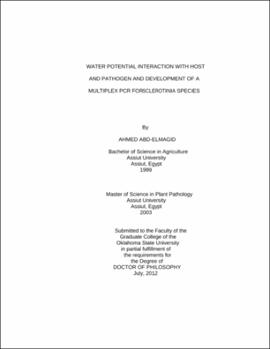| dc.contributor.advisor | Melouk, Hassan | |
| dc.contributor.author | Abd-Elmagid, Ahmed | |
| dc.date.accessioned | 2013-11-26T08:23:41Z | |
| dc.date.available | 2013-11-26T08:23:41Z | |
| dc.date.issued | 2012-07 | |
| dc.identifier.uri | https://hdl.handle.net/11244/6726 | |
| dc.description.abstract | Scope and Method of Study: Soil water potential (Ψ) is an important parameter that affects the development of plant diseases. Sclerotinia blight of peanut caused by S. minor and S. sclerotiorum has been chosen as a model for soil-borne diseases. To study the effect of Ψ on Sclerotinia blight, the following objectives have been addressed: 1) the effect of Ψs and Ψm on the vegetative growth in vitro and sclerotia viability of the pathogens. Mycelia were grown on Potato Dextrose Agar (PDA) media amended to different Ψs and Ψm. The Area under Mycelial Progress Curve (AUMGPC), sclerotia number and germination were recorded; 2) Study the pathogenicity of mycelial inocula of the pathogens produced at various Ψs and Ψm. Seedlings of "Okrun" cultivar were infected by mycelia produced at various Ψs and Ψm. Lesions lengths were recorded daily; 3) Determine the effect of water stress on the infection of the cv. Okrun by the two pathogens. Seedlings received PEG 8000 and on the sixth week, plants were infected by the inoula of the pathogens. Lesions lengths were recorded daily. Tan spot of wheat has been chosen as a model for foliar diseases. The following objectives have been addressed: 1) Determine the role of Ψ on mycelial growth, conidia production and germination of Pyrenophora tritici-repentis (PTR); 2) Determine the effect of Ψ on initiation and maturation of pseudothecia of PTR on wheat straw in vitro; 3) Study the impact of water stress on the infection of wheat "TAM105" cultivar by PTR. In a separate project a Multiplex PCR for the most important species of the Genus Sclerotinia was developed. | |
| dc.description.abstract | Findings and Conclusions: Mycelial growth of S. minor and S. sclerotiorum tolerated a wide range of Ψs and Ψm, up to -4.0 and -3.5 MPa, respectively. Sclerotial formation and germination of the two pathogens occurred at Ψs and Ψm lower than those at which most crops seeds germination is curtailed -1.4 to -2.0 MPa. Pathogens can retain their virulence under high levels of Ψs and Ψm. Okrun stressed plants had smaller lesions. In tan spot system, low Ψ decreased vegetative growth, conidia production and germination, pseudothecia production and maturation of PTR on wheat straws. Increasing water stress predisposed TAM 105 to tan spot. The developed multiplex PCR was rapid, sensitive and specific to separate between S. minor, S. homeopcarpa, S. sclerotiorum and S. trifoliorum. | |
| dc.format | application/pdf | |
| dc.language | en_US | |
| dc.rights | Copyright is held by the author who has granted the Oklahoma State University Library the non-exclusive right to share this material in its institutional repository. Contact Digital Library Services at lib-dls@okstate.edu or 405-744-9161 for the permission policy on the use, reproduction or distribution of this material. | |
| dc.title | Water potential interaction with host and pathogen and development of a multiplex PCR for Sclerotinia species | |
| dc.contributor.committeeMember | Hunger, Robert | |
| dc.contributor.committeeMember | Garzon, Carla | |
| dc.contributor.committeeMember | Payton, Mark | |
| osu.filename | AbdElmagid_okstate_0664D_12208.pdf | |
| osu.accesstype | Open Access | |
| dc.type.genre | Dissertation | |
| dc.type.material | Text | |
| dc.subject.keywords | multiplex pcr | |
| dc.subject.keywords | sclerotinia minor | |
| dc.subject.keywords | sclerotinia sclerotiorum | |
| dc.subject.keywords | tan spot | |
| dc.subject.keywords | water potential | |
| thesis.degree.discipline | Entomology and Plant Pathology | |
| thesis.degree.grantor | Oklahoma State University | |
